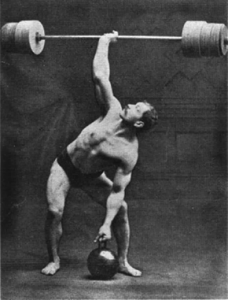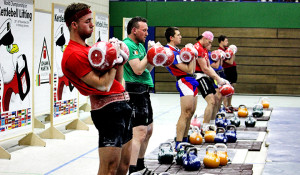In the world of Kettlebell sport the 1-arm swing is the foundational movement. The contested movements are the kettlebell snatch and the kettlebell clean & jerk. Success is predicated upon a firm grasp of the 1-arm swing which underlies both the clean and the snatch. Nonetheless, the 1-arm swing is a great exercise on its own which has tremendous carryover to other athletic endeavors.
Unfortunately, the kettlebell is underutilized and misunderstood amongst the crossfit community. The 2-arm American swing, the go-to-exercise in CrossFit) is a great exercise in regard to its ability to deliver a potent training stimulus. The 1-arm swing, however, might be a better tool in the development of athletic movement. Specifically, the development of rotational power.
All unilateral movements (1-arm or 1-legged movements) demand an athlete either generate rotational forces or resist rotational forces. Running, punching, kicking, throwing, swinging are all powerful unilateral movements where rotational forces must be managed. It is in the teaching and developing rotational movement that many CrossFit coaches and athletes have a blindspot. As CrossFit has developed into its own sport that ultimately tests for power output, we have cornered ourselves into a relying on a body of movements that only operate in the sagital plane. As most of our daily battles in the gym are against gravity we have become extremely adept at moving up and down. However, in nearly all other sports we need lateral and rotational movements on the field of play. And coaches and gyms that have a bigger picture of fitness beyond purely CrossFit style competitions recognize this and program and teach accordingly.
Let’s get back to the point, the 1-arm swing. The basic understanding of how to perform this movement is flawed in the general public. The bottom and top positions are both done incorrectly for purposes of power, alignment and transferability. I have detailed here what the important aspects of the top of the swing are.
1) Square the hips and shoulders at the top
2) Keep your shoulders down and back
3) Relax your elbow down and squeeze your armpit closed
4) Turn your thumb to about 45 degrees above horizontal
5) Stop at about shoulder height with the bell in front of your nose.
1-arm kettlebell swing top position analysis from Force Distance Time on Vimeo.
I have detailed here what the important points are for the bottom of the swing.
1) Have the bell completely back through your legs
2) Have your arm glued to your body
3) Have your shoulders rotated
4) Keep your legs relatively straight and work on hinging forward rather than squatting down
5) Make sure the non-swinging arm is swinging as well to assist in proper rotation
1-arm kettlebell swing bottom position from Force Distance Time on Vimeo.
Finally let’s look at a few swings in their totality to get a sense of how they should be performed.
1-arm kettlebell swing analysis from Force Distance Time on Vimeo.
I encourage you to go and pick up a kettlebell and start swinging and record yourself and see if you can dial in the 1-arm swing. Once you do, then we can move towards the snatch and the clean. Have fun and train hard.
“Stick to the basics and when you feel you’ve mastered them it’s time to start all over again, begin anew – again with the basics – this time paying closer attention.” – Coach Greg Glassman


